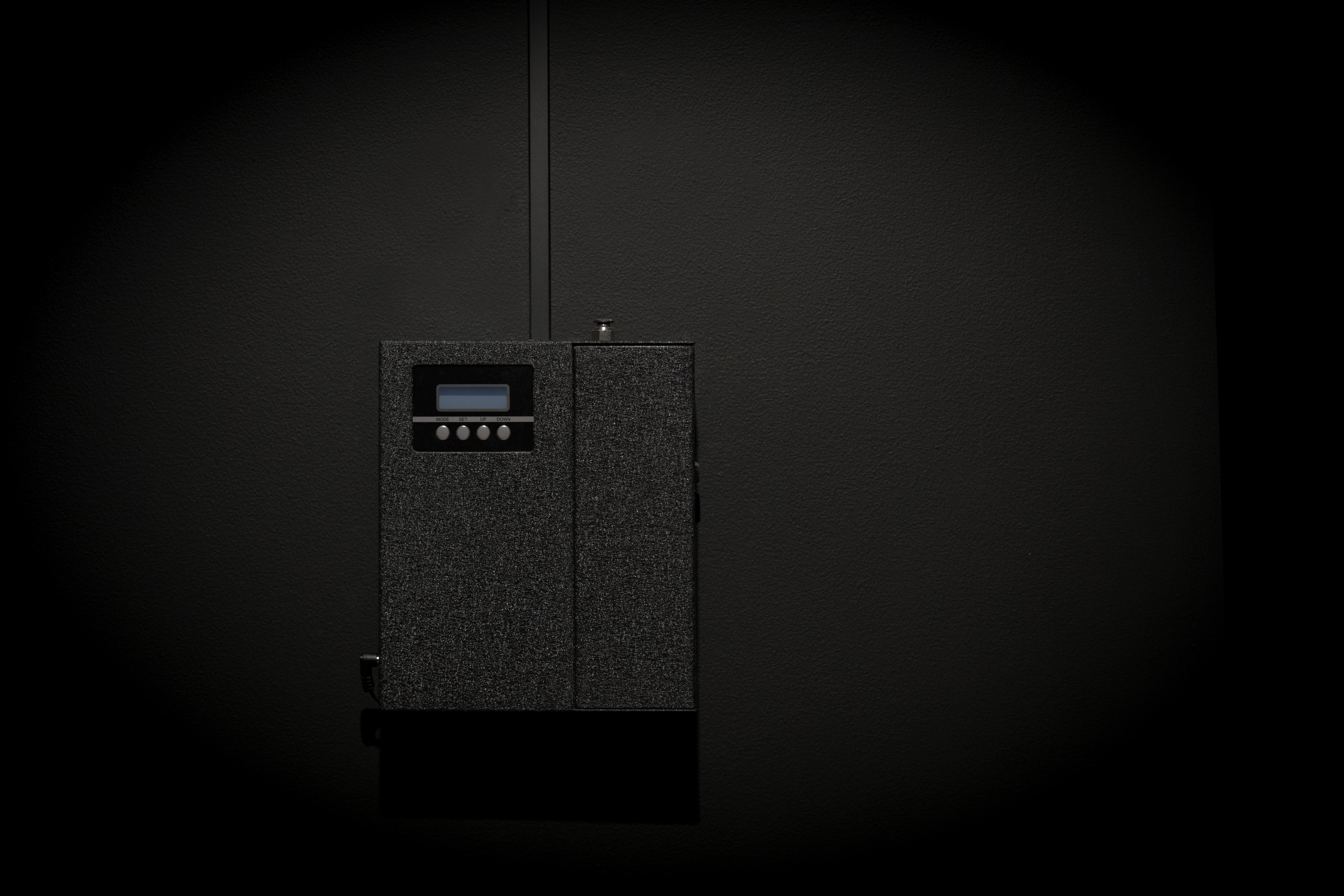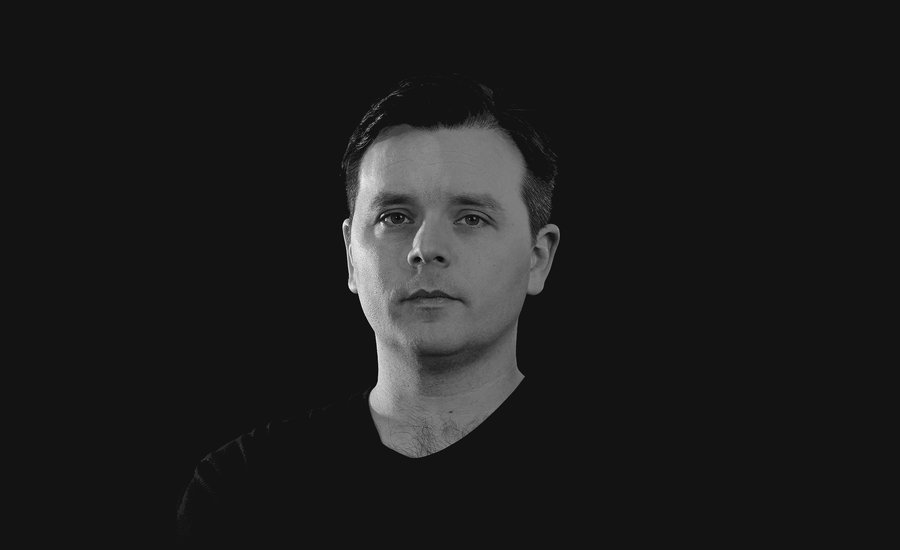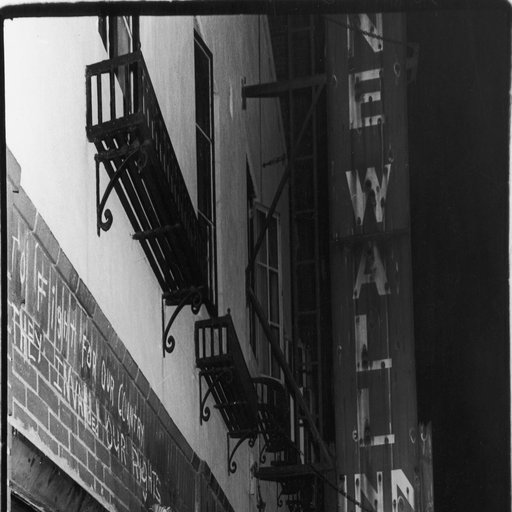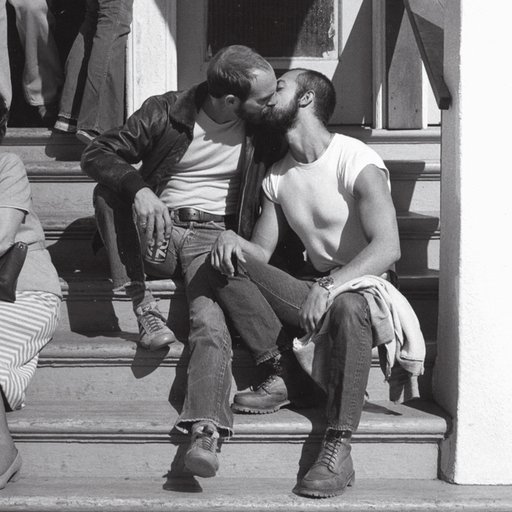Perception is, of course, the first step to appreciating art. We first have to use our senses to experience a work of art before we're able to consider it. For artist Sean Raspet, though, perception isn't only involved in viewing art, it's the very material used to make art. Sight and smell—subjective experiences—are also objective, or objects rather, at least in the case of Raspet's current exhibition at Empty Gallery in Hong Kong (on view until September 7).
For the show entitled "New Molecules and Stem Cell Retinoid Screen," Raspet collaborated with scientist Kiara Eldred to grow actual human tissue—the kind that forms part of our eyes—to essentially create a living, human sculpture. With ocular cells and cone receptors, the sculpture—shaped like a screen—can see, "looking" back at us as we look at it. Living and growing inside the gallery, it sits nearby wall-mounted diffusers that emit scent. These scents are, most simply put, molecules—molecules that were designed and synthesized in a lab by Raspet and his team. They exist no where else on Earth.
Raspet is a self-taught chemist and scientist, whose laboratory/studio treats molecules as art material, and consumers and the mass marketplace as his audience and exhibition platform. His goal: to disseminate his microscopic artworks outside of the gallery and into the mainstream. Here, we speak with the artist over the phone about the science behind his stranger-than-fiction artworks, his drive to disperse his works into the world beyond the cube, and the reason why artists really don't need to make anything new.
For your current show at Empty Gallery in Hong Kong, you designed and synthesized three brand-new fragrance molecules, which are diffused electronically from machines mounted to the walls. Can you describe what they smell like?
I can describe them with the best of my ability, but part of my interest is in the gap between direct experience and what's possible to express in language, which I think is pretty limited. But in terms of how I perceive them, Fructaplex© has a soft, slightly plastic-y, slightly sweet-fruity aspect, and is a little bit floral. It's a scent that tends to go more in the background. You can smell it directly but it's a modifying scent, so it can change the perception of other scents. The next one in the exhibition is Sylvoxime©, which is certainly on the woody, amber-y side of things. It's warm, soft, and a little bit sweet, very rich, but also has some aspects of sage, or plant-y-ness... herbal. And the third one is called Hyperflor©, and it has a very strong floral smell. I've heard it described as an orchid scent, slightly tropical, or some people have said it's very much like a rose, including the green plant. I've also heard it described as the taste when you bight into an apple—that greenness.
 Fructaplex (2-(3,3-dvimethylcyclohexyl)-2,5,5-trimethyl-1,3-dioxane), 2018-2019. 2-(3,3-dvimethylcyclohexyl)-2,5,5-trimethyl-1,3-dioxane diffused via electronic diffuser. Artwork produced in collaboration with Shengping Zheng. Image courtesy of the artist and Empty Gallery. Photo: Michael Yu.
Fructaplex (2-(3,3-dvimethylcyclohexyl)-2,5,5-trimethyl-1,3-dioxane), 2018-2019. 2-(3,3-dvimethylcyclohexyl)-2,5,5-trimethyl-1,3-dioxane diffused via electronic diffuser. Artwork produced in collaboration with Shengping Zheng. Image courtesy of the artist and Empty Gallery. Photo: Michael Yu.
What is the process of creating a new scent molecule like?
There's a good amount of trial and error. I usually find a good starting molecule and then think of ways that different chemical reactions with other molecules would transform it into a different kind of sent. What are the molecules that you're starting with? What are the molecules you're adding? What are the different catalysts to get different chemical reactions? And then what's the finished molecule that you want? Often the finished molecule that you want might make sense theoretically but when you get into the lab it's not as straight forward.
We usually think of scent as being representational, right? Like, the smell of coffee represents the object of coffee, or the act of brewing coffee. Your project points out that scents are, first and foremost, chemistry, and they can be completely abstract, completely independent of anything that exists in the world, totally non-referential. I'm assuming that that is actually case for most of the scents we encounter, at least in consumer products—is that right?
Any fragrance or flavor that's added to a consumer product is just made from a combination of molecules. Sometimes those are calculated to evoke a certain thing, but there's not any real connection between the thing that it evokes and the actual material of the scent itself. For example, if you buy a product that's strawberry flavor, there might not be any connection to an actual strawberry; the molecules were synthesized by other means or they were extracted from other plants besides strawberries and then purified and remixed into a different composition. To me, that's very interesting—the gap between the perception of something and what it actually is. And then what other ways there are to play with the material of scent, and make things that are not straightforwardly representational.
You are what you eat. And you are what you smell maybe too. If so much of what we're consuming is synthetic, are we synthetic? Are we cyborgs? Is the relationship between natural and artificial something you're thinking about in your work?
On a material level, there's no molecular difference between consuming a flavor that's artificial versus a natural flavor or a flavor that's already present in a fruit, let's say. So a very faithful representation of a strawberry flavor, if its done artificially, may have the same exact molecules that you'd find in a strawberry, it's just that the molecules came from a different process, through industry—but they're still the same molecules. On a scientific or material basis, they're indistinguishable.
You filed provisional patents for the scent molecules that you made. This is obviously a very novel gesture for an artist to make... but for some context, how common is this outside the art world? Why would someone create a so-called "captive molecule"?
In the flavor and fragrance industry, a lot of the work is done by a few large companies, and those companies have teams of chemists who look to synthesize new molecules that haven't existed before because then they can patent it. Then the company can use it in their fragrance formulations, and another company can't. (Most patents last for 20 years.) Eventually they'll modify the chemical a little bit later in the life of the patent and then actually sell it to the other competing companies. There's some point where the economics of it make more sense for the company to be the exclusive manufacturer of this molecule.
This isn't the first time you've exhibited fragrances. You've shown fragrances at Bridget Donahue and at the Artists Institute, and you've filed patents for some of those fragrances. Were you ever able to license them to other companies?
One of the molecules that's in Empty Gallery was also in the Artists Institute show. I ended up rolling it into a broader patent, so in a way it's a continuation of that earlier work. The two other molecules we've developed since then, but I'm working with the same team of chemists from Hunter College. What we ended up doing is taking more of our research from the last year and putting it into a large patent. It could take another potentially two years to get the patent.
So hypothetically, if patented and licensed, these molecules (that are also artworks) can be distributed in consumer products (laundry detergent or air freshener or something like that), which could allow them to enter people's every-day lives in a way that art typically doesn't, and in a way where the consumers of the work don't even know that what they're doing is participating in an artwork in that sense. How important is it to you that your work gets circulated beyond the art world? For these works to be successful in your mind, do they need to eventually become part of some other consumer product?
Yeah, definitely, that's pretty much crucial. That's the main goal. I see the gallery exhibition as almost like a product showcase or like a de facto trade show. We've invited some people from different fragrance companies to visit, and we're also talking with them aside from the actual show. I would say, if we don't commercialize any of them, then they still existed as an artwork in this brief instance, but it seems to me that it's not really achieving the potential that I'd like.
I want to keep talking about this show but you mentioned treating the exhibition as a trade show, which made me think of that Societé booth at Frieze where you exhibited refrigerated display cases filled with bottles of Soylent. To follow this tangent, I know that you worked for Soylent to produce new flavors for them. How did that come about? And how do you feel about collaborating with companies versus artists or scientists?
It's kind a case by case thing. I worked at Soylent when I did that project at Societé, so I was actually an employee working as a flavorist and developing prototypes, mostly behind the scenes. But the reason I started working at Soylent was from this interest in taking the kind of work that I had been doing in my studio or in an art context and putting that into a mass circulation paradigm. That's very important to me. In general, I see there's an increasing amount of collaboration between artists and brands. But I think any sort of collaboration should meet the innovation that a new product would also have. So ideally the artist is not just lending some credibility or brand recognition in the art world to the collaboration. Ideally there's actually a new product, or even better, a new change in the production process. That's just my personal take. For me, I want to make changes at the level of production, not at the level of branding or packaging.
This company that I co-founded, Nonfood, is essentially producing a new food product using algae, and along with that comes a completely different production line and set-up. As it scales it has an increasing material impact on the food system because it's very resource efficient. So in terms of collaboration, hopefully there's the potential for the artist to make an actual material change in the company, in the production process—but I'm not sure that always happens with these collaborations. If a company isn't willing to make a change to its production practices then it's not really a collaboration, it's essentially a marketing thing.
 Image via Nonfood
Image via Nonfood
A big difference between art and mainstream consumer products, and something that doesn't seem to be brought up too much in your work, is this issue of function or usefulness. Nonfood and Soylent are both very useful in that they're providing a sustainable alternative to food. Is there a function to the work at Empty Gallery? Or is this issue of functional verses not functional even a useful way to think about your work?
I think that's a very good point because obviously food is the necessity—the one thing that you can't really strip away. You still fundamentally need food of some sort. The fragrance molecules, to the extent that they're commercialized, are functional but they're part of an aesthetic layer that's added to products. There are products that are on the market that are already scented; it's already a widespread practice. But within an art context, it's interesting to at least shift away from work that is just sitting in the gallery and to make it more widespread... to replace that layer of scent that would otherwise be a different scent. I think it's good to limit art to things that are going to be made anyway, rather than making something extra. That's something I'm interested in: trying to put the limit on producing anything new for the world and just rearranging the things that are already being produced. Then eventually, hopefully, changing things even on a wider level to reduce the things that are being produced in the first place, because obviously there's a huge problem with over production in the present economy.
Let's talk about the other piece in the show. It's really the only tangible sculpture, which is a transparent cube with a grid inside that consists of living retinal organoids.... What is that?
The retinol organoid is essentially human retinal tissue that grows in a very small clump. So it's not a full-sized retina but it has gone through a lot of the development that you would see in a human retina of that age. In the exhibition now, I think they're coming into about 130 days, so they've started to grow their first color receptors. But essentially, we started with stem cells and exposed them to a certain growth media and certain types of hormones and chemical signals that then pushed them to differentiate from what they call a 'pluripotent stem cell' that can turn into anything towards a nerve cell, first, then eventually an optical nerve cell, then eventually a retina. This work is a collaboration with Kiara Eldred. She's a scientist at Johns Hopkins and she recently finished her PHD, so she developed the process for all of this and wrote a research paper along with her team at the lab detailing how to take a pluripotent stem cell and eventually convert it into a retinal stem cell. So these are grown from stem cells and they are living and functioning retinal cells, so they have the capacity to see, essentially, in the sense that they can respond to light. When a proton hits one of their receptors it goes through the process of activating a nerve, just like in your own eyes.
 Screen (EP1.1 iPSCs stem cell line-derived human retinal organdies), 2018 - 2019. induced pluripotency episomal-derived EP1.1 iPSCs human stem-cells developed into functioning retinal organdies via small molecule signaling. 6 x 6 resolution. Incubator design by Joseph Stewart. Artwork produced in collaboration with Kiara Eldred. Image courtesy of the artist and Empty Gallery. Installation shots credit: Michael Yu.
Screen (EP1.1 iPSCs stem cell line-derived human retinal organdies), 2018 - 2019. induced pluripotency episomal-derived EP1.1 iPSCs human stem-cells developed into functioning retinal organdies via small molecule signaling. 6 x 6 resolution. Incubator design by Joseph Stewart. Artwork produced in collaboration with Kiara Eldred. Image courtesy of the artist and Empty Gallery. Installation shots credit: Michael Yu.
The sculpture will responds to light, but without a brain, can we really say it sees?
When I say it responds to light, it responds on a cellular level. So the light is causing a cellular response and then that gets transferred throughout the organoid, but it doesn't process that information, of course. There's no brain attached to it. It's purely seeing, or it's pure sight without any additional processing.
So is part of what you're getting at here distilling perception into this purely biological process, as if to say perception isn't just a human phenomenon or even a natural phenomenon?
That's an interesting aspect of it—the idea of perception as a kind of material. They are living, they're human-based. I mean, they are human, essentially, but they're a very different material array. With this project I was very interested in thinking about what is the materiality of a human, what is the materiality of perception, and thinking of it as something that is kind of plastic, something that can be changed. Indeed, these kinds of materials—human stem cells—are something that are being worked with in labs by certain companies. So to work in that type of material is interesting—to see what can be done there.
Also, for this particular work I was also very interested in a reversal. The work is called Screen , and the cells are arranged in a 6-by-6 grid, so it forms a kind of screen. We obviously perceive screens throughout our lives as things that respond to what we want, or as something that is passive. The screens that we're mostly exposed to project red, green, and blue light, and then our retinas receive that light, and the different cone receptors process that into further information to us. With this piece there is a reversal, where the material of the retina itself is growing these different receptors and then a screen is formed of that.
The scientists that you work with—what are they getting out of this? What's in it for the science community?
That's a good question. I think I was very lucky that I reached out to a group of scientists who are open-minded and interested in the possibilities of what they're doing. Actually, when I reached out to the main professor who leads up this lab at Johns Hopkins, it took a couple days before I heard back. I later heard that he was processing whether this looked like a scam, or what this email was about. But he said since there was a good amount of detail, had been thoroughly researched, and also made sense in terms of the idea I was proposing, they decided to call and talk further, and then eventually I visited the lab. I guess this might be a question for the scientists, but I think Kiara is a very creative person—most scientists are, and they're really thoroughly interested in what they're doing, and whether there's another way pushing what they're doing in a different direction and seeing what happens. I can only speculate but I think it was also an opportunity do something a little bit fun.
To wrap up: Do you have anything coming up you'd like to mention?
One of the molecules that I developed here, Hyperflor©, is going to be a part of the Okayama Art Summit, which is coming up in the fall. I'll basically be diffusing it outside in a garden area. Also, along with that, there's a project where I've found these mutant morning glories that have been exposed to gamma radiation through this institute in Japan, and they have different coloration and slightly different properties than regular morning glories. We've planted them along a long outdoor garden wall. So that's an upcoming project.
RELATED ARTICLES:
An Interview with Eco-Philosopher Timothy Morton on Art and the Hyper-Object
Slime Mold, Glow-in-the-Dark Bunnies, and "Victimless Leather": 9 BioArtists You Should Know
























